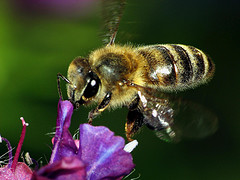Beekeeping is rewarding for lots of reasons. For some the main reward is honey, but often what really draws you in as a beekeeper is that bees as a species are just so fascinating. So here are 10 interesting honey bee facts – but believe me, there are many more!
1. Honey bees are the only insect that produces food eaten by man.
2. The average worker bee produces about 1/12th teaspoon of honey in her lifetime.
3. A hive of bees will have to fly a total of 55,000 miles to get enough nectar to make 1 pound of honey – equivalent to flying twice around the planet earth.
4. Bees will fly up to 6 miles from their hive to collect pollen and nectar.

Pollination in action!
5. Bees have 2 pairs of wings, which move incredibly fast – about 200 beats per second. This is what makes honey bees buzz!
6. At its peak in the summertime, there will be about 60,000 worker bees in a colony, 2,000 drones and just one queen. The worker bees are all female, and do all the work.
7. Drones are the male honey bees. They are noticeably larger than worker bees, have no stinger and do no work at all. Their only job is to mate with a queen bee. Only one drawback – after they mate, they die.
8. The queen bee only leaves the hive once to mate, with up to 20 drones. When she returns to the hive, her only job is to lay eggs – up to 2,500 eggs per day when the colony is at its busiest in the summer months.
9. The queen controls the colony by releasing pheromones which get passed from one bee to another through contact. If these pheromones become too weak, it is taken as a signal that the queen needs to be replaced (or ‘superceded’).
10. The new queen comes from exactly the same eggs as worker bees – but because she is fed a different diet (of ‘royal jelly’) she develops into a queen rather than a worker. Definitely a case of “you are what you eat!”
Why not experience these fascinating creatures for yourself, and Continue reading


